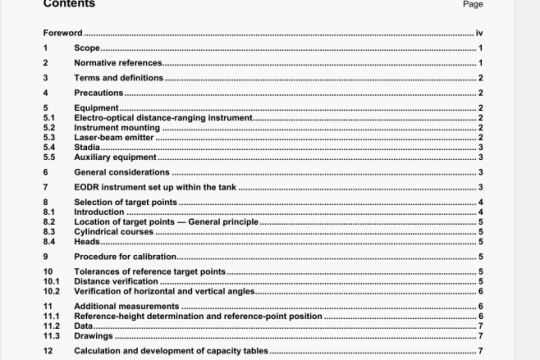ISO 7599:2018 pdf download
ISO 7599:2018 pdf download.Anodizing of aluminium and its alloys – Method for specifying decorative and protective anodic oxidation coatings on aluminium.
h) whether the product is to be sealed or left unsealed, and if it is to be sealed, what sealing method is to be used.
Significant surfaces as per d) above are indicated preferably by drawings or by suitably marked test specimens; in some cases, there can be different requirements for the finish on different parts of the significant surface(s).
The surface preparation as per e) above is indicated preferably by agreed samples; guidance on surface preparation is given in Annex B.
NOTE Guidance on the choice of aluminium is given in Annex A.
4.3 Additional information
Additional information can be required for certain applications and, if so, shall be specified by the customer, if necessary in consultation with the anodizer. It includes the following:
a) the type of anodizing and the colouring process to be used;
b) details of any formal sampling plans required;
c) the preferred position and maximum size of contact marks;
d) any limits of variation of final surface finish on the significant surface(s);
e) the colour of the anodized article(s) and maximum limits of colour variation (see el);
f) any requirements for quality of sealing;
g) any requirements for corrosion resistance and the method of test to be used;
h) any requirements for abrasion resistance, the property to be tested and the measurements required (i.e. wear resistance, wear resistance coefficient, wear index, mass wear index, mean specific abrasion resistance) and the method of test to be used;
i) any requirements for resistance to cracking by deformation;
j) any requirements for fastness to light or ultraviolet radiation of coloured anodic oxidation coatings;
k) any requirements for light reflection properties, i.e. total reflectance, specular reflectance, specular gloss, diffuse reflectance and image clarity;
1) any requirements for electric breakdown potential;
m) any requirements for the continuity of the anodic oxidation coating;
n) any requirements for the mass per unit area (surface density) of the coating.
Acceptable limits of variation of final surface finish as per d) above are identified preferably by agreed limit samples.
Acceptable maximum limits of colour variation as per e) above are identified preferably by agreed limit samples.
5 Tests
5.1 Sampling procedures
Sampling procedures shall be specified by the customer. Guidance on the choice of suitable sampling procedures is given in ISO 2859-1.
5.2 Test specimens
Wherever practicable, test specimens shall be production components. However, if by agreement special test specimens are prepared for convenience in referee or acceptance tests, they shall be of the same alloy as the production components and processed through the anodizing line at the same time as the production components.
5.3 Acceptance tests
Acceptance tests shall be as specified by the customer.
5.4 Referee tests
In cases of dispute, the appropriate referee tests specified in this document shall be used.
5.5 Production control tests
Tests for production control purposes shall be at the discretion of the anodizer.
6 Coating thickness
6.1 General
Anodic oxidation coatings are designated by their thickness class. The required thickness of a coating is of the utmost importance and shall always be specified.
6.2 Classification
Anodic oxidation coatings are graded according to the minimum allowed value of the average thickness (minimum average thickness) in micrometres. The thickness classes are designated by the letters “AA”, followed by the thickness grade; typical thickness classes are given in Table 1.
For anodic oxidation coatings designed to impart particular surface properties, an average thickness higher than typical may be selected, and additional intermediate values of average thickness may be specified if necessary, but in no case shall the minimum local thickness be less than 80 % of the minimum average thickness. The choice of thickness class will depend on relevant national standards.




